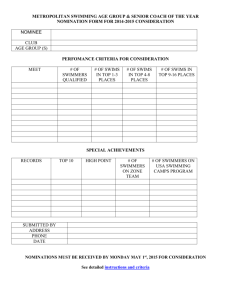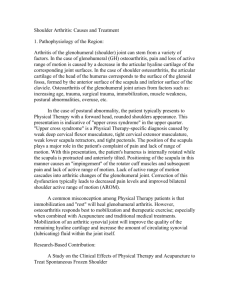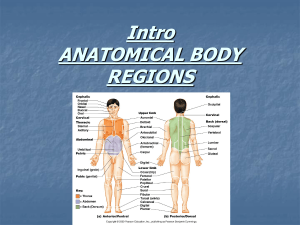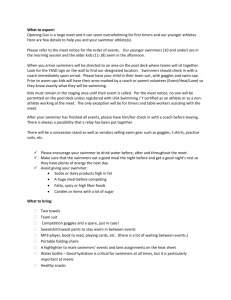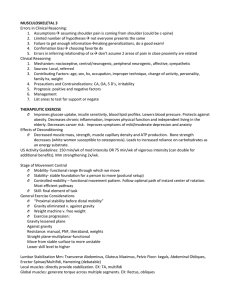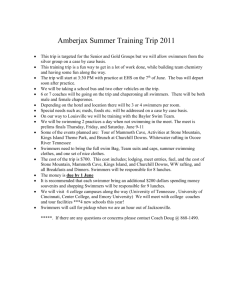Sonographic Stress Measurement of Glenohumeral Joint Laxity in Collegiate
advertisement
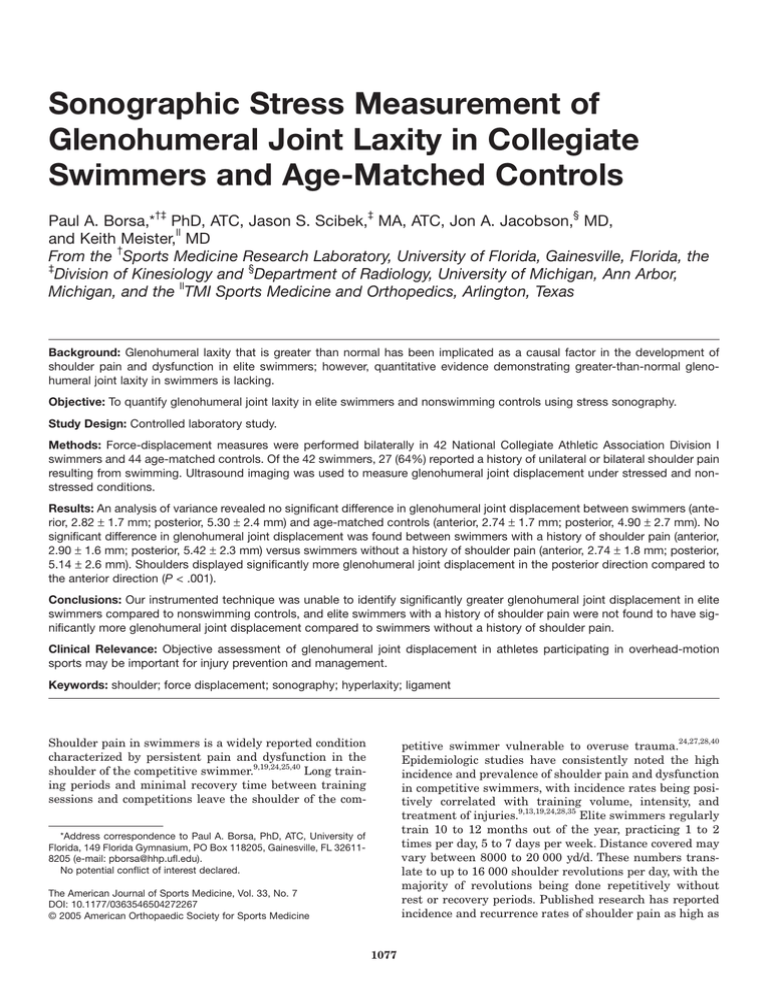
Sonographic Stress Measurement of Glenohumeral Joint Laxity in Collegiate Swimmers and Age-Matched Controls Paul A. Borsa,*†‡ PhD, ATC, Jason S. Scibek,‡ MA, ATC, Jon A. Jacobson,§ MD, ll and Keith Meister, MD † From the Sports Medicine Research Laboratory, University of Florida, Gainesville, Florida, the ‡ Division of Kinesiology and §Department of Radiology, University of Michigan, Ann Arbor, ll Michigan, and the TMI Sports Medicine and Orthopedics, Arlington, Texas Background: Glenohumeral laxity that is greater than normal has been implicated as a causal factor in the development of shoulder pain and dysfunction in elite swimmers; however, quantitative evidence demonstrating greater-than-normal glenohumeral joint laxity in swimmers is lacking. Objective: To quantify glenohumeral joint laxity in elite swimmers and nonswimming controls using stress sonography. Study Design: Controlled laboratory study. Methods: Force-displacement measures were performed bilaterally in 42 National Collegiate Athletic Association Division I swimmers and 44 age-matched controls. Of the 42 swimmers, 27 (64%) reported a history of unilateral or bilateral shoulder pain resulting from swimming. Ultrasound imaging was used to measure glenohumeral joint displacement under stressed and nonstressed conditions. Results: An analysis of variance revealed no significant difference in glenohumeral joint displacement between swimmers (anterior, 2.82 ± 1.7 mm; posterior, 5.30 ± 2.4 mm) and age-matched controls (anterior, 2.74 ± 1.7 mm; posterior, 4.90 ± 2.7 mm). No significant difference in glenohumeral joint displacement was found between swimmers with a history of shoulder pain (anterior, 2.90 ± 1.6 mm; posterior, 5.42 ± 2.3 mm) versus swimmers without a history of shoulder pain (anterior, 2.74 ± 1.8 mm; posterior, 5.14 ± 2.6 mm). Shoulders displayed significantly more glenohumeral joint displacement in the posterior direction compared to the anterior direction (P < .001). Conclusions: Our instrumented technique was unable to identify significantly greater glenohumeral joint displacement in elite swimmers compared to nonswimming controls, and elite swimmers with a history of shoulder pain were not found to have significantly more glenohumeral joint displacement compared to swimmers without a history of shoulder pain. Clinical Relevance: Objective assessment of glenohumeral joint displacement in athletes participating in overhead-motion sports may be important for injury prevention and management. Keywords: shoulder; force displacement; sonography; hyperlaxity; ligament Shoulder pain in swimmers is a widely reported condition characterized by persistent pain and dysfunction in the shoulder of the competitive swimmer.9,19,24,25,40 Long training periods and minimal recovery time between training sessions and competitions leave the shoulder of the com- petitive swimmer vulnerable to overuse trauma.24,27,28,40 Epidemiologic studies have consistently noted the high incidence and prevalence of shoulder pain and dysfunction in competitive swimmers, with incidence rates being positively correlated with training volume, intensity, and treatment of injuries.9,13,19,24,28,35 Elite swimmers regularly train 10 to 12 months out of the year, practicing 1 to 2 times per day, 5 to 7 days per week. Distance covered may vary between 8000 to 20 000 yd/d. These numbers translate to up to 16 000 shoulder revolutions per day, with the majority of revolutions being done repetitively without rest or recovery periods. Published research has reported incidence and recurrence rates of shoulder pain as high as *Address correspondence to Paul A. Borsa, PhD, ATC, University of Florida, 149 Florida Gymnasium, PO Box 118205, Gainesville, FL 326118205 (e-mail: pborsa@hhp.ufl.edu). No potential conflict of interest declared. The American Journal of Sports Medicine, Vol. 33, No. 7 DOI: 10.1177/0363546504272267 © 2005 American Orthopaedic Society for Sports Medicine 1077 1078 Borsa et al 80% in competitive swimmers in the United States.9,13,19,24,25,28,35 Although the true cause of shoulder pain in swimmers is unclear, most published reports suggest that shoulder pain and dysfunction are due in part to glenohumeral joint laxity that is greater than normal.1,3,4,19,23,27,42 In athletes participating in sports involving repetitive overhead motion, greater-than-normal laxity is thought to predispose the glenohumeral joint to episodes of instability in which the humeral head will subluxate on the glenoid during overhead activity.1,18,27,29 Greater-than-normal joint laxity does not in itself imply instability; only when joint laxity produces symptoms of giving way is a joint considered to be unstable.27 Repeated episodes of humeral head subluxation are thought to expose the rotator cuff tendons (specifically the supraspinatus tendon) to mechanical impingement, which eventually progresses to pain and dysfunction.3,9,18,29,42 Glenohumeral joint laxity has traditionally been assessed using manual stress tests aimed at gauging the extent of translational movement based on the “feel” of the humeral head.10 Recent studies using manual laxity tests have noted increased glenohumeral joint laxity in swimmers23,29,42; however, other research has found these tests to be nonreproducible and examiner dependent.14,21,39 Studies using objective measures to quantify glenohumeral laxity in swimmers are currently lacking.37 Consequently, little scientific evidence exists that quantifies patterns of greater-than-normal glenohumeral joint laxity in swimmers and the relationships these patterns may have to the development of overuse pain and functional impairment. Instrumented arthrometry for the glenohumeral joint, similar to the KT-1000 arthrometer (MedMetric Corp, San Diego, Calif), is currently available and provides a means to quantify translatory or accessory motion.30,31 Therefore, our objective was to quantify glenohumeral laxity in elite swimmers and nonswimming controls using instrumented arthrometry. The specific aims were (1) to determine whether swimmers have significantly more glenohumeral laxity than do age-matched controls and (2) to determine whether swimmers with a history of shoulder pain have significantly greater laxity than swimmers without a history of shoulder pain. METHODS Subjects and Design A mixed-model (1 between-factor, 1 within-factor) repeated-measures design was used to assess glenohumeral laxity in 42 National Collegiate Athletic Association Division I swimmers (26 men, 16 women) and 44 age-matched controls (26 men, 18 women) (Table 1). All data collection was performed during the preseason or off-season, when swimmers were not actively engaged in intercollegiate competitions. All swimmers were asymptomatic at the time of testing; they reported no interfering pain during overhead activity and displayed full, pain-free active range of motion during shoulder elevation in both the sagittal and scapular planes. Control subjects were also asymptomatic at the The American Journal of Sports Medicine TABLE 1 Subject Characteristics Age, y Group Women Swimmers Controls Men Swimmers Controls Height, cm Weight, kg Mean SD Mean SD Mean SD 19.7 18.7 1.0 0.6 170 165.3 7.2 5.5 65.5 62.3 4.5 8.5 19.4 21.5 1.6 3.3 187.9 179.4 6.6 9.7 82.3 79.2 6.2 16.6 time of testing and had no history of long-term participation (>5 years) in overhead-motion sports or occupations. Of the 42 swimmers, 27 (64%) reported a history of unilateral or bilateral shoulder pain resulting from swimming. The breakdown between genders was even, with 16 of 26 men (61%) and 11 of 18 women (62%) reporting a history of shoulder pain. The reported source of pain was multifactorial: 17 athletes reported pain from rotator cuff tendinitis, 5 from biceps tendinitis, 3 from nonspecific sources, 1 from thoracic outlet syndrome, and 1 from a labral tear. Only 1 swimmer reported having arthroscopic surgery in the form of a subacromial decompression to remove scar tissue. Athletes reported having swum competitively for 11.8 (±2.3) years. On average, swimmers trained between 10 to 12 months per year, during which time they practiced 1 to 2 times per day for 6 days per week, with an average of 2 hours per practice session (~24 hours per week). Average weekly distance covered was reported to be slightly more than 62 000 yd, with a range between 40 000 to 90 000 yd depending on whether the athlete was a sprinter (lower end), middle distance (average), or distance (upper end) swimmer. Approval for this research study was granted from the University of Michigan’s Institutional Review Board for the protection of human subjects. Each subject read and signed an informed consent document before participating in the study. Instrumentation Force-displacement measures were performed bilaterally using a graded stress technique. Shoulders were positioned at 90° of abduction and 60° of external rotation in the scapular plane using the Telos system (Telos, Weiterstadt, Germany).36 The Telos system consists of a frame for positioning the shoulder, 2 adjustable counterbearings for stabilizing the shoulder girdle, and a stress device for applying forces to the proximal humerus. The anterior counterbearing was placed against the coracoid process and the posterior counterbearing on the scapular spine medial to the acromion process. A portable ultrasound scanner (Model CTS-285 with 5.0 MHz Convex Probe, SIUI, Guangdong, China) was used to dynamically track glenohumeral motion in real time during force application. A board-certified radiologist with 10 years of expe- Vol. 33, No. 7, 2005 Glenohumeral Joint Laxity in Swimmers 1079 A B Figure 1. Force-displacement measures with the arm positioned and stabilized at 90° of abduction and 60° of external rotation. Force applicator applied anterior-directed (A) and posterior-directed (B) forces to the proximal humerus. rience as a musculoskeletal sonologist (J.A.J.) performed all ultrasound imaging. The sonologist was experienced with this particular stress-measurement technique, having performed more than 100 trials prior to this study. Test Procedures The sonographic stress-measurement technique used for this study was found to be reproducible and valid for assessing glenohumeral joint displacement.5 A posterior approach for dynamically tracking glenohumeral joint motion, similar to that described by Jerosch et al,17 was used. After the subject was positioned in the Telos device, anterior- and posterior-directed forces of 15 dN (150 N) were applied to the proximal humerus (Figure 1). The test order for side (dominant/nondominant) and direction (anterior/posterior) was performed in a random manner. The ultrasound scan for each trial was video recorded and saved in MPEG format to a laptop computer (Inspiron Figure 2. Anterior displacement trial with the x-y anatomical coordinate system marked. The long solid line represents the x-axis and depicts the flat segment of the scapula, whereas the left dot indicates the posterior glenoid and the right dot (with arrow) depicts the posterior humeral head. The broken line represents the y-axis and identifies the distance of the humeral head from the x-axis. Displacement was measured and recorded as the difference in movement between the baseline image (top) and the 15-dN force level (bottom). 7500, Dell Computer Corp, Round Rock, Tex), which was interfaced with the ultrasound scanner using a commercial software program (Studio PCTV, 1.04, Pinnacle Systems Inc, Mountain View, Calif). During video playback, static images were captured at baseline (no force) and at the 15-dN force level. For each image, hyperechoic bony landmarks were consistently identified and marked by the sonologist (J.A.J.) on the scapula and humeral head, creating a biaxial (x-y axes) anatomical coordinate system (Figure 2). The plane of the scapula served as the x-axis and a perpendicular line drawn from the x-axis to a point on the humeral head served as the y-axis. Marked images were later printed and evaluated by the primary author (P.A.B.) in a blinded and randomized fashion. Using the anatomical coordinate system as a frame of reference, the examiner measured the difference in humeral head excursion between the 2 force levels using a digital caliper (Model 700-103B, Mitutoyo, Aurora, Ohio; instrumental error, ±0.2 mm; resolution, 0.1 mm). Displacement was recorded for each direction as the difference between the baseline and 15-dN force levels. 1080 Borsa et al The American Journal of Sports Medicine TABLE 2 Mean Glenohumeral Displacement Measurements (in millimeters) Between Swimmers and Controlsa Swimmers Nonswimmers Difference Measurement Mean SD Mean SD Mean SD Anterior Posterior 2.82 5.30 2.74 4.90 1.7 2.7 0.08 0.40 1.7 2.5 1.7 2.4 a All arms were positioned and stabilized at 90° of abduction and 60° of external rotation. anterior-posterior (AP) glenohumeral joint displacement. Separate repeated-measures ANOVAs were performed on our sample, and we found no significant side-to-side differences in glenohumeral joint displacement (F1,85 = 1.81, P = .18) as well as no significant differences in glenohumeral joint displacement between men and women (F1,85 = 0.78, P = .38). For side-to-side comparisons, AP displacement was found to be 8.24 ± 4.5 mm in the dominant shoulder and 7.52 ± 3.5 mm in the nondominant shoulder. Regarding gender, AP displacement was found to be 8.25 ± 2.8 mm for women and 7.64 ± 3.4 mm for men. Therefore, we proceeded by collapsing the data for side and gender for our primary statistical analysis, using subject type (swimmers vs controls) as the only between-group factor and direction (anterior vs posterior) as the only within-group factor. Swimmers Versus Controls Figure 3. Anterior and posterior glenohumeral displacements between swimmers and controls in response to a 15dN applied force (mean ± SD). The asterisk (*) indicates that posterior displacement was significantly greater than anterior displacement for both groups (P < .01). The ANOVA revealed no significant difference in glenohumeral joint displacement between swimmers and agematched controls (F1,84 = 0.47, P = .49) (Figure 3, Table 2). At 15-dN of applied force, anterior displacement was 2.82 ± 1.7 mm and posterior displacement was 5.30 ± 2.4 mm for elite swimmers, compared to 2.74 ± 1.7 mm of anterior displacement and 4.90 ± 2.7 mm of posterior displacement for nonswimming controls. The main effect for direction was significant, with shoulders displaying more glenohumeral joint displacement in the posterior direction (5.10 ± 2.6 mm) compared to the anterior direction (2.78 ± 1.7 mm) (F1,84 = 53.2, P < .001) (Figure 3). History of Shoulder Pain Versus No History of Shoulder Pain Statistical Procedures The data were analyzed using separate 2-factor analyses of variance (ANOVAs). The first ANOVA was used to determine significant mean differences between group (swimming vs control) and direction of force (anterior vs posterior). The second ANOVA was used to determine significant differences between groups (swimmers with a history of shoulder pain vs swimmers without a history of shoulder pain) and direction of force (anterior vs posterior). In the presence of a significant interaction effect, Tukey least significant difference post hoc analyses (pairwise comparisons) were used to identify simple main effects. All data analyses were performed using SPSS for Windows 11.0 (SPSS Inc, Chicago, Ill). The level of statistical significance was set a priori at the α = .05 level. The ANOVA revealed no significant difference in glenohumeral joint displacement between swimmers with a history of shoulder pain versus swimmers without a history of shoulder pain (F1,40 = 0.17, P = .68) (Figure 4, Table 3). At 15-dN of applied force, anterior displacement was 2.90 ± 1.6 mm and posterior displacement was 5.42 ± 2.3 mm for swimmers with a history of shoulder pain, compared to 2.74 ± 1.8 mm of anterior displacement and 5.14 ± 2.6 mm of posterior displacement for swimmers with no history of shoulder pain. The main effect for direction was significant, with shoulders displaying more glenohumeral displacement in the posterior direction (5.30 ± 2.4 mm) compared to the anterior direction (2.82 ± 1.7 mm) (F1,40 = 33.3, P < .001) (Figure 4). Post Hoc Power Analysis RESULTS Preliminary Analysis Preliminary analyses were performed to determine if there were significant between-gender (male vs female) and side-to-side (dominant vs nondominant) differences in Because our statistical findings yielded insignificant results, we performed a power analysis post hoc to determine what a clinically significant difference between the 2 groups would be. Therefore, we estimated a clinically significant between-group mean difference to be 1.5 ± 2.0 mm. Using these values, we calculated an effect size (d) = 0.75. We then used an online power analysis application Vol. 33, No. 7, 2005 Glenohumeral Joint Laxity in Swimmers TABLE 3 Mean Glenohumeral Displacement Measurements (in millimeters) Between Swimmers With and Without a History of Shoulder Paina History No History Difference Measurement Mean SD Mean SD Mean SD Anterior Posterior 2.90 5.42 2.74 5.14 1.8 2.6 0.16 0.28 1.7 2.4 1.6 2.3 a All arms were positioned and stabilized at 90° of abduction and 60° of external rotation. Figure 4. Anterior and posterior glenohumeral displacements between swimmers with and without a history of shoulder pain in response to a 15-dN applied force (mean ± SD). The asterisk (*) indicates that posterior displacement was significantly greater than anterior displacement for both groups (P < .01). (GPOWER version 2.0f, http://www.psycho.uni-duesseldorf. de/aap/projects/gpower/) to perform the analyses. For our first comparison (swimmers vs controls), at α = .05 and sample sizes of n1 = 44 (controls) and n2 = 42 (swimmers), our analysis yielded a power of 0.9644 (t84 = 1.66, δ = 3.477). For the second comparison (swimmers with a history of shoulder pain vs swimmers without a history of shoulder pain), using the same criteria except new sample sizes of n1 = 18 (no history) and n2 = 24 (history), our power was found to be 0.7641 (t40 = 1.684, δ = 2.41). DISCUSSION Preliminary Analysis: Side-to-Side and Between-Gender Differences In our preliminary analysis, we were able to rule out any significant side-to-side and between-gender differences in glenohumeral joint displacement. Our findings are in agreement with previous studies by Borsa et al6 and Sauers et al,30,31 who have consistently documented no significant side-to-side differences in glenohumeral laxity in the shoulders of subjects not engaged in overhead- 1081 throwing sports. Glenohumeral displacement was very symmetrical between sides, with a mean side-to-side difference of less than 1 mm (8.24 mm in the dominant shoulder vs 7.52 mm in the nondominant shoulder). Our findings are similar to those of Tibone et al,37 who found mean side-to-side differences to be 1.4 mm (12.4 mm in the dominant and 13.8 mm in the nondominant shoulders) in a group of swimmers and soccer players. From these results, it does not appear that significant differences in glenohumeral laxity exist between the dominant and nondominant shoulders in swimmers. Between-gender differences in glenohumeral laxity have also been previously reported by Borsa et al,7 who found increased glenohumeral laxity in healthy female subjects compared to healthy male subjects. Borsa et al7 measured glenohumeral laxity with the arm in adduction and neutral rotation, whereas the present study measured laxity with the arm abducted and externally rotated in subjects who participated in overhead-throwing sports and subjects who did not participate in these sports. This difference in results may suggest that between-gender differences in glenohumeral laxity may be dependent on shoulder position. More research is necessary to substantiate these findings. Glenohumeral laxity in swimmers that is greater than normal is considered by many to be advantageous, given that increased shoulder mobility has been directly correlated with greater stroke length, swimming speed, and overall swimming performance.40,42 Swimmers are routinely diagnosed with multidirectional shoulder instability without displaying signs of general joint hyperlaxity.3 Rarely do swimmers complain of the joint giving way or subluxating during overhead activity; rather, the primary complaint is interfering pain and weakness during training.27 The actual diagnosis of instability is usually made in the presence of positive tests for excessive laxity and apprehension during physical examination.10,15,27 Debate continues as to whether shoulder hyperlaxity is inherent (genetically endowed) or acquired because of adaptive change. Some researchers speculate that hyperlaxity is inherent, which in turn predetermines athletes to the sport of swimming, whereas others suggest that hyperlaxity develops as a direct result of microtrauma and capsular attenuation.18,24,25,42 Between-Group Comparisons: Swimmers Versus Age-Matched Controls Our findings did not reveal a significant difference in glenohumeral joint displacement between elite swimmers (defined as having Division I collegiate status as well as more than 10 years of experience in competitive swimming) and nonswimming control subjects. Furthermore, our findings do not support the supposition that the glenohumeral joints of elite swimmers are inherently hyperlax and/or acquire hyperlaxity through adaptive change to the joint capsuloligamentous restraints.¶ Swimmers were compared to an age-matched nonswimming control group and were found to have similar levels of joint displacement ¶ References 1, 3, 9, 18, 19, 24, 27, 28, 40, 42. 1082 Borsa et al when assessed in both the anterior and posterior directions. Quantitatively, the between-group difference in joint displacement was 0.08 mm for anterior displacement and 0.4 mm for posterior displacement (Table 2). In a similar study, Tibone et al,37 using an electromagnetic spatial tracking system equipped with cutaneous sensors, found significant differences in AP glenohumeral translation between swimmers and soccer players. On average, swimmers were found to have 3 mm more AP translation than soccer players (swimmers, 13 mm; soccer players, 10 mm). The instrumented technique used by Tibone et al was considerably different than the technique used in the present study. Tibone et al37 had their subjects positioned supine on a treatment table with the arm at 90° of abduction in neutral rotation, whereas our study had subjects seated with the shoulder in 60° of external rotation. In addition, Tibone et al37 did not use a standard application force; it was instead manually applied, and glenohumeral motion was measured superficially using motion sensors held against the skin. Future research will clarify the reasons for these differences. Directional Asymmetry From a directional standpoint, the glenohumeral joint displayed almost twice the amount of posterior displacement than anterior displacement (5.10 mm posterior vs 2.78 mm anterior) in the test position of 90° of abduction and 60° of external rotation in the scapular plane. Glenohumeral translation is known to be position dependent; therefore, the magnitude of translation may vary depending on the position of the joint during assessment.40 With the humerus in adduction and neutral rotation, researchers have shown quantitatively that AP translation is symmetrical.6,30,31 Using multiple positions of humeral abduction and rotation during AP-translation measurements may provide a clearer picture of glenohumeral laxity. From an anatomical and functional standpoint, this particular test position is useful for evaluating the structural integrity of the static restraints that resist humeral head displacement during overhead activity. In this test position, the glenohumeral joint capsule is placed under selective tension, thereby providing increased joint compression and stability during force-displacement maneuvers. The posterior capsule is the thinnest portion of the entire glenohumeral capsule, whereas the anteroinferior capsule and inferior glenohumeral ligament have been described as the thickest and strongest portions.41 This element may account for the asymmetries found between the anterior and posterior displacement measures. With the shoulder in the functional position of abduction and external rotation, the thick anteroinferior ligaments are able to sufficiently resist humeral head displacement during anteriordirected forces. Conversely, in this test position, the thin posterior capsule may provide less resistance during posterior loading, and as a result, it may allow more posterior displacement to occur. Furthermore, the minimal anterior displacement we found in the abducted and externally rotated position indicates that the primary static restraints to anterior humeral displacement are intact in The American Journal of Sports Medicine our swimming group and not attenuated, as previously reported.18 Jobe et al18 theorized that repetitive and forceful overhead activity as seen in swimmers causes a gradual stretching out of the anteroinferior capsuloligamentous structures. The theory by Jobe et al18 suggests that the attenuation of the capsuloligamentous restraints allows the humeral head to subluxate during overhead activity, causing further capsuloligamentous and rotator cuff tendon damage. Our hypothesis that elite swimmers would display significantly more glenohumeral joint displacement than would nonswimming controls was based upon previous reports citing increased shoulder laxity and hypermobility 3,9,24,27,42 McMaster et al24 referred to inherin swimmers. ent shoulder laxity as the common denominator in com24 petitive swimmers with shoulder pain. McMaster et al further stated that shoulder overuse may have a laxitypotentiating effect on the shoulder capsule. Zemek and 42 Magee noted shoulder hyperlaxity in both recreational and elite swimmers, implicating both inherent and 27 acquired causes. Pink and Tibone, in a recent review, commented on the presence of inherent laxity in swimmers that is seen during clinical examination as increased 3 anterior and inferior translations. Bak and Faunø noted that the majority of competitive swimmers in their study demonstrated increased humeral head translation in the anteroinferior direction. In all of these particular studies, manual laxity tests were used to identify the presence of excessive laxity. The subjective nature of these tests, coupled with the reported lack of reproducibility, underscores the importance of using instrumented techniques when performing range of motion assessments on joints, especially when small bony excursions are elicited. Our study differs from the previous studies in that we were able to objectively quantify the magnitude of humeral head displacement using a novel force-displacement technique. Through the integration of a force actuator and a sonographic imaging device, we were able to accurately and consistently visualize and record force-induced changes in the position of the glenohumeral joint. The distinct advantages of this technique are direct visualization and dynamic tracking of joint structures during laxity assessments, along with the use of standard forces and joint positions. In addition, the use of ultrasound imaging eliminated patient exposure to ionizing radiation, as 8,12,14,26 and it also eliminated would occur with radiography, the need for invasive procedures such as the pinning of motion sensors directly to bone structures, as has been 16,22 done in previous kinematic studies. Between-Group Comparisons: Swimmers With a History of Shoulder Pain Versus Swimmers Without a History of Shoulder Pain Our secondary aim was to test the hypothesis that swimmers with a history of shoulder pain would have significantly greater joint displacement than swimmers without a history of shoulder pain, thus providing insight into a possible relationship between glenohumeral hyperlaxity and history of shoulder pain. Our findings likewise did not Vol. 33, No. 7, 2005 show a significant difference in glenohumeral joint displacement between swimmers with a history of shoulder pain and those without a history of shoulder pain. It should be noted that we studied a group of swimmers who were able to return to swimming at the elite level after injury. It may be possible that we would have obtained different results if we had studied a group of swimmers who were disabled by shoulder pain to the point of terminating their careers or undergoing surgery. This would have been a more extreme group, and therefore we may have found more extreme physical findings. Published reports have commented on the presence of secondary impingement in swimmers, citing hyperlaxity as a possible contributing factor.3 Our findings suggest that hyperlaxity may not be a causative agent in the development of swimmer’s shoulder as previously reported. We feel that a more plausible explanation for the high incidence of swimmer’s shoulder could be eccentric tensile overloading of the supraspinatus tendon2,32,34 and/or mechanical impingement secondary to fatigue-induced scapular dyskinesis.20 An inability of the scapular muscles to upwardly rotate and posteriorly tilt the scapula may expose the tendon to impingement.11,20 Likewise, an inability of the humeral dynamic stabilizers to position the humeral head on the glenoid during overhead motion could also expose the tendon to some form of impingement. Scibek and Borsa33 and Crotty and Smith11 found deficits in scapular upward-rotation measurements after an intensive practice session when compared to prepractice measurements. Wadsworth and Bullock-Saxton38 found diminished recruitment patterns of scapular rotator muscles in swimmers with interfering pain. These findings implicate a possible association between scapular dyskinesis and shoulder pain and dysfunction in swimmers. To effectively prevent and treat shoulder pain in swimmers, continued research is necessary to determine the role of glenohumeral joint laxity in overhead motions as well as to uncover the true causal factors for shoulder pain in elite swimmers. CLINICAL IMPLICATIONS Maintaining glenohumeral stability during overhead activity is considered by many sports medicine professionals to be essential for functional performance and injury prevention. From a clinical perspective, our findings, coupled with the findings of impaired scapular function during swimming,11,33,38 suggest that the primary focus be directed toward neuromuscular factors when considering injury prevention, assessment, and treatment of shoulder injuries in swimmers. Injury prevention and intervention strategies should focus on muscular strength, endurance, and neuromuscular control of the scapulohumeral stabilizers and movers for sustained power and scapular control during overhead activity. In addition, special attention may be directed toward the posterior wall muscles to help stabilize the humeral head during overhead activity, thus minimizing excessive posterior humeral displacement. Glenohumeral Joint Laxity in Swimmers 1083 CONCLUSION Our findings provide objective evidence that swimmers do not have excessive glenohumeral joint displacement compared to nonswimming controls. In addition, swimmers with a history of shoulder pain do not appear to have significantly more glenohumeral laxity compared to swimmers without a history of shoulder pain. It does not appear that elite swimmers have inherent glenohumeral hyperlaxity, nor do they acquire excessive laxity as a result of long-term participation in a sport with repetitive overhead activity. ACKNOWLEDGMENT The authors thank the coaching staff and members of the University of Michigan men’s and women’s swimming teams for their cooperation and participation in the study. REFERENCES 1. Allegrucci M, Whitney SL, Irrgang JJ. Clinical implications of secondary impingement of the shoulder in freestyle swimmers. J Orthop Sports Phys Ther. 1994;20:307-318. 2. Arroyo JS, Hershon SJ, Bigliani LU. Special considerations in the athletic throwing shoulder. Orthop Clin North Am. 1997;28:69-78. 3. Bak K, Faunø P. Clinical findings in competitive swimmers with shoulder pain. Am J Sports Med. 1997;25:254-260. 4. Bak K, Magnusson SP. Shoulder strength and range of motion in symptomatic and pain-free elite swimmers. Am J Sports Med. 1997;25:454-459. 5. Borsa PA, Jacobson JA, Scibek JS, Dover GC. Comparison of dynamic sonography to stress radiography for assessing glenohumeral laxity in asymptomatic shoulders. Am J Sports Med. 2005; 33:734-741. 6. Borsa PA, Sauers EL, Herling DE. In vivo assessment of AP laxity in healthy shoulders. J Sport Rehabil. 1999;8:157-170. 7. Borsa PA, Sauers EL, Herling DE. Patterns of glenohumeral joint laxity and stiffness in healthy men and women. Med Sci Sports Exerc. 2000;32:1685-1690. 8. Chen S-K, Simonian PT, Wickiewicz TL, Otis JC, Warren RF. Radiographic evaluation of glenohumeral kinematics: a muscle fatigue model. J Shoulder Elbow Surg. 1999;8:49-52. 9. Ciullo JV. Swimmer’s shoulder. Clin Sports Med. 1986;5:115-137. 10. Clarnette RC, Miniaci A. Clinical exam of the shoulder. Med Sci Sport Exerc. 1998;30:1-6. 11. Crotty NMN, Smith J. Alterations in scapular position with fatigue: a study in swimmers. Clin J Sport Med. 2000;10:251-258. 12. Deutsch A, Altchek DW, Schwartz E, Otis JC, Warren RF. Radiologic measurement of superior displacement of the humeral head in the impingement syndrome. J Shoulder Elbow Surg. 1996;5:186-193. 13. Dominguez RH. Shoulder pain in age group swimmers. Int Series Sports Sci. 1978;6:105-109. 14. Ellenbecker TS, Mattalino AJ, Elam E, Caplinger R. Quantification of anterior translation of the humeral head in the throwing shoulder: manual assessment versus stress radiography. Am J Sports Med. 2000;28:161-167. 15. Hamner DL, Pink MM, Jobe FW. A modification of the relocation test: arthroscopic findings associated with a positive test. J Shoulder Elbow Surg. 2000;9:263-267. 16. Harryman DT, Sidles JA, Harris BS, et al. Laxity of normal glenohumeral joint: a quantitative in vivo assessment. J Shoulder Elbow Surg. 1992;1:66-76. 1084 Borsa et al 17. Jerosch J, Marquardt M, Winkelmann W. Ultrasound documentation of translational movement of the shoulder joint: normal values and pathologic findings [in German]. Ultraschall Med. 1991;12:31-35. 18. Jobe FW, Kvitne RS, Giangarra CE. Shoulder pain in the overhead or throwing athlete: the relationship of anterior instability and rotator cuff impingement. Orthop Rev. 1989;18:963-975. 19. Kennedy JC, Hawkins R, Krissoff WB. Orthopaedic manifestations of swimming. Am J Sports Med. 1978;6:309-322. 20. Kibler WB. The role of the scapula in athletic shoulder function. Am J Sports Med. 1994;26:325-337. 21. Levy AS, Lintner S, Kenter K, Speer KP. Intra- and interobserver reproducibility of the shoulder laxity examination. Am J Sports Med. 1999;27:460-463. 22. Lippitt SB, Harris SL, Harryman DT, et al. In vivo quantification of the laxity of normal and unstable glenohumeral joints. J Shoulder Elbow Surg. 1994;3:215-223. 23. McMaster WC. Anterior glenoid labrum damage: a painful lesion in swimmers. Am J Sports Med. 1986;14:383-387. 24. McMaster WC, Roberts A, Stoddard T. A correlation between shoulder laxity and interfering pain in competitive swimmers. Am J Sports Med. 1998;26:83-86. 25. McMaster WC, Troup J. A survey of interfering shoulder pain in United States competitive swimmers. Am J Sports Med. 1993;21:6770. 26. Papilion JA, Shall LM. Fluoroscopic evaluation for subtle shoulder instability. Am J Sports Med. 1992;20:548-552. 27. Pink MM, Tibone JE. The painful shoulder in the swimming athlete. Orthop Clin North Am. 2000;31:247-261. 28. Richardson AB, Jobe FW, Collins HR. The shoulder in competitive swimming. Am J Sports Med. 1980;8:159-163. 29. Rupp S, Berninger K, Hopf T. Shoulder problems in high level swimmers—impingement, anterior instability, muscular imbalance? Int J Sports Med. 1995;16:557-562. The American Journal of Sports Medicine 30. Sauers EL, Borsa PA, Herling DE. Instrumented measurement of glenohumeral joint laxity: reliability and normative data. Knee Surg Sports Traumatol Arthrosc. 2001;9: 34-41. 31. Sauers EL, Borsa PA, Herling DE, Stanley RD. Instrumented measurement of glenohumeral joint laxity and its relationship to passive range of motion and generalized joint laxity. Am J Sports Med. 2001;29:143-150. 32. Scarpinato DF, Bramhall JP, Andrews JR. Arthroscopic management of the throwing athlete’s shoulder: indications, techniques, and results. Clin Sports Med. 1991;10:913-927. 33. Scibek JS, Borsa PA. Swimming practice significantly reduces scapular upward rotation. J Athl Train. 2003;38:S11. 34. Silliman JF, Hawkins RJ. Current concepts and recent advances in the athlete’s shoulder. Clin Sports Med. 1991;10:693-705. 35. Stocker D, Pink M, Jobe FW. Comparison of shoulder injury in collegiate- and master’s-level swimmers. Clin J Sport Med. 1995;5:4-8. 36. Telos Medical Equipment. Telos Shoulder Positioning Device Manual. Fallston, Md: Austin & Associates; 1996. 37. Tibone JE, Lee TQ, Csintalan RP, Dettling J, McMahon PJ. Quantitative assessment of glenohumeral translation. Clin Orthop. 2002;400:93-97. 38. Wadsworth DJS, Bullock-Saxton JE. Recruitment patterns of the scapular rotator muscles in freestyle swimmers with subacromial impingement. Int J Sports Med. 1997;18:618-624. 39. Warner JJ, Micheli LJ, Arslanian LE, Kennedy J, Kennedy R. Patterns of flexibility, laxity, and strength in normal shoulders and shoulders with instability and impingement. Am J Sports Med.1990;18:366-375. 40. Weldon EJ, Richardson AB. Upper extremity overuse injuries in swimming: a discussion of swimmer’s shoulder. Clin Sports Med. 2001;20:423-438. 41. Wilk KE, Arrigo CA, Andrews JR. Current concepts: the stabilizing structures of the glenohumeral joint. J Orthop Sports Phys Ther. 1997;25:364-379. 42. Zemek MJ, Magee DJ. Comparison of glenohumeral joint laxity in elite and recreational swimmers. Clin J Sport Med. 1996;6:40-47.
